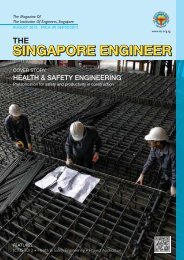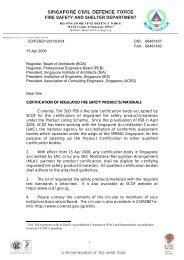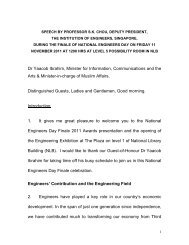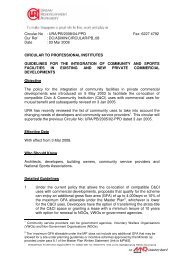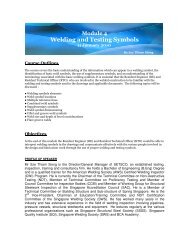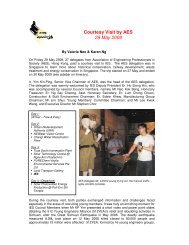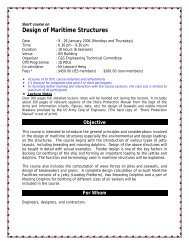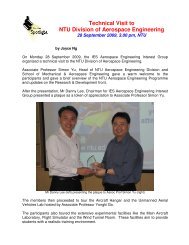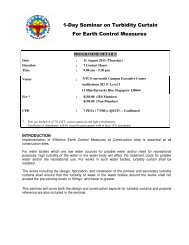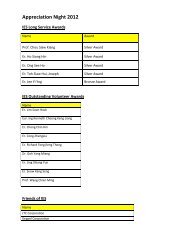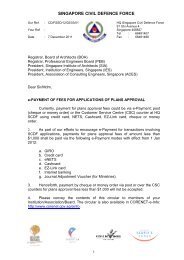THE SINGAPORE ENGINEER - Institution of Engineers Singapore
THE SINGAPORE ENGINEER - Institution of Engineers Singapore
THE SINGAPORE ENGINEER - Institution of Engineers Singapore
You also want an ePaper? Increase the reach of your titles
YUMPU automatically turns print PDFs into web optimized ePapers that Google loves.
SYSTEMS COVER <strong>ENGINEER</strong>ING<br />
STORY<br />
So the V does work!<br />
The Systems Engineering V diagram shows all the previously<br />
mentioned principles <strong>of</strong> design verification being differentiated<br />
from product verification, iteration equalling the first design<br />
verification and definition parameters at one level becoming the<br />
requirements at the next level down.<br />
These principles easily map onto the traditional Systems<br />
Engineering V. Viewed in this way, it is an enhancement <strong>of</strong> the<br />
traditional V and more closely reflects the way a product evolves<br />
from requirements, through iterations <strong>of</strong> definitions, to an<br />
eventual product.<br />
Any ‘suspicious linkages’ now include the verification evidence<br />
that should be interrogated to confirm (or otherwise) the<br />
‘suspicion’ and quantify the non-compliance. The number <strong>of</strong> links<br />
needing maintaining is also potentially reduced. Another major<br />
advantage is that the verification evidence is now visually part <strong>of</strong><br />
the process rather than an ‘addition’.<br />
The chosen information model<br />
As indicated above, the Requirements Management process<br />
within Rolls-Royce was intended to be applicable outside<br />
the purely technical domain and thereby embrace business<br />
requirements, supply chain requirements etc equally well. It also<br />
had to be applicable at all levels from ‘the top’ layer down to the<br />
component layer.<br />
Inspecting the Systems Engineering V diagram, there is a very<br />
clear fractal. This was chosen as the information model - it is<br />
simple, completely scaleable between layers and scaleable<br />
across a whole enterprise and can be represented by a cluster<br />
<strong>of</strong> documents and/or modules in a formal Requirements<br />
Management tool.<br />
CODIFICATION IN A FORMAL PROCESS<br />
Clearly, the complete process <strong>of</strong> managing requirements consists<br />
<strong>of</strong> more than just the above information model. However,<br />
applying the above information model across a complete<br />
enterprise will ‘govern’ the Requirements Engineering aspect.<br />
Before the Requirements Engineering starts, requirements will<br />
need to be elicited and validated. The lifecycle also has to include<br />
the management <strong>of</strong> non-compliance. All aspects are shown in<br />
the process diagram.<br />
The process<br />
As can be seen, the process is conveniently divided into three<br />
distinct phases, all <strong>of</strong> which are codified in a formal, controlled<br />
Rolls-Royce Global Quality Procedure.<br />
Stakeholder Analysis and Requirements Capture<br />
There are many ‘elegant’, formal Systems Engineering tools<br />
that should be used, as appropriate, for this stage. These are<br />
not detailed here but merely acknowledged as potentially<br />
fundamental to this stage <strong>of</strong> the process.<br />
Requirements Engineering.<br />
In terms <strong>of</strong> the cascade, this is described in detail in the<br />
discussion around the Information Model. The method by<br />
which new requirements are derived as solutions to complex<br />
requirements is again, fundamentally dependent on formal<br />
Systems Engineering techniques.<br />
Documentation Structure<br />
Being pragmatic, it was accepted that it would be a cultural<br />
shift too far to manage all requirements only in a formal tool,<br />
including sign-<strong>of</strong>f. It was therefore accepted that documentation<br />
would be expected. A document structure already existed<br />
Diagram showing the fractal cluster at the systems level.<br />
24 <strong>THE</strong> <strong>SINGAPORE</strong> <strong>ENGINEER</strong> April 2012



